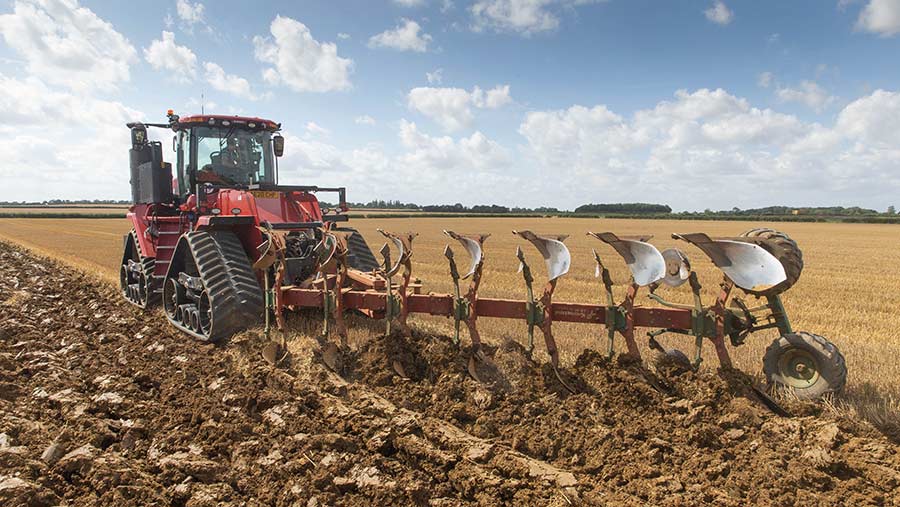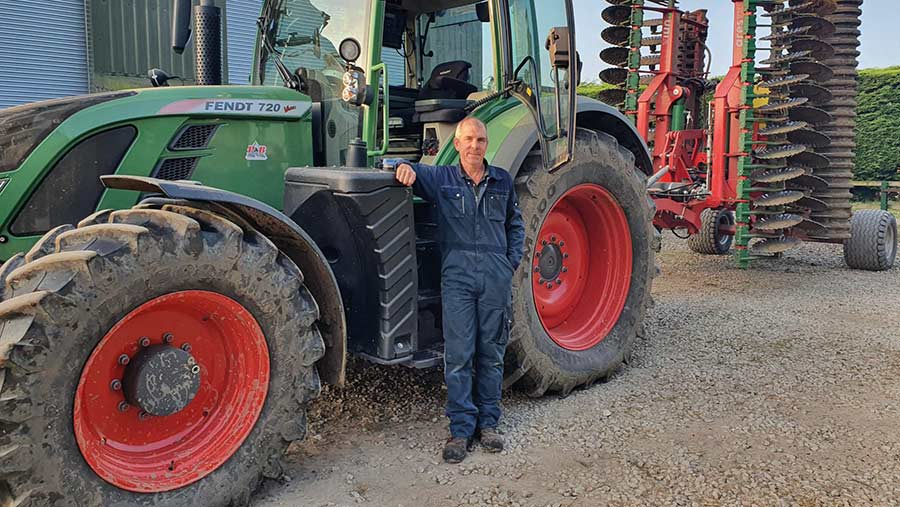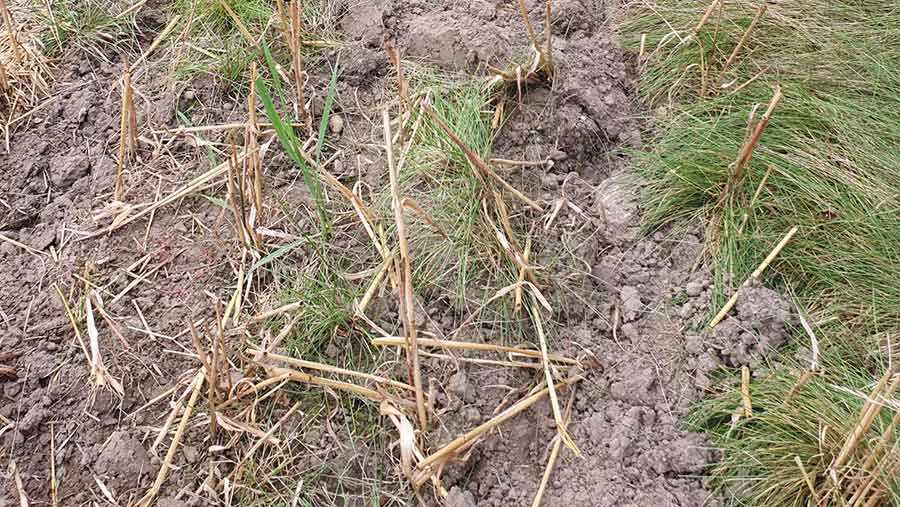How one farmer tackled invasive grassweed rat’s tail fescue
 © Tim Scrivener
© Tim Scrivener Lurking in many UK fields lies an invasive grassweed known as rat’s-tail fescue, which is of increasing concern to arable growers due to its rapid development and natural herbicide resistance.
The very competitive annual grassweed already poses a threat to farmers in many nations overseas, and populations are now beginning to take hold across the UK.
Predominantly a threat in winter cereals established via minimum cultivation or direct drilling, sporadic populations of rat’s-tail fescue can rapidly develop to form a dense carpet, which competes with the main crop.
See also: 10 learnings from more than 21 years of blackgrass trials
This is why early intervention and grower awareness of how to quickly identify and control the weed is key in preventing its further spread.
Farm facts
- Hagg Farm (115ha)
- Cropping includes winter wheat, spring wheat, spring oats and winter beans
- Operates a minimum tillage system where the plough has not been used for at least 20 years – some fields for 25 years
- All crops planted with a weaving GD direct drill
- Soil type: medium clay loam
Yorkshire infestation

One grower to experience issues with rat’s-tail fescue is Yorkshire farmer Nic Drever-Smith, who first identified the weed in a crop of winter linseed, back in 2019.
After never previously suffering from the grassweed at Hagg Farm – where a min-till establishment system has been used for the past 20-25 years – the weed “appeared from nowhere” and swamped an entire headland.
This resulted in a 1.5ha area of his 11ha linseed crop being lost. Like blackgrass, rat’s-tail fescue can spread rapidly and can quickly build up a large seed bank.
Consequently, he now sees a scattering of populations across his 115ha farm in the Vale of York with a medium clay loam soil type.
Only two fields have been badly affected, where Mr Drever-Smith hopes his changes to cropping and stale seed-bed management have prevented the spread.
“The weed surge was too much to rogue by hand. We applied a graminicide, but this was a waste of time due to natural resistance, so we have planted the field to spring cropping ever since, which has managed to reduce numbers,” he says.
The cause?
He believes the flare up was linked with an awkward field corner which he took out of production, planted to an Entry Level Stewardship grass mix and later re-drilled to commercial cropping.
He suspects the grassweed spread from grass margins, as the species is known for its dispersal from fallow ground.
Deciding to bring the field corner back into production a few years later, the grass mix was sprayed off with glyphosate, disced and subsequently drilled with two successful crops of winter wheat.
It wasn’t until 2019, when winter linseed was planted in this same field, that the weed made an unwelcome appearance due to limited linseed-approved herbicides, which allowed the weed to move in and take hold.
Not knowing what the unusual grass species was, he contacted his Procam agronomist David Hannington, who identified it as rat’s-tail fescue.
Cultural control
“Rat’s-tail fescue is a challenging weed to spot in crops, is difficult to hand rogue and is naturally resistant to a number of graminicides,” explains Mr Hannington.
“Ploughing is the main way of alleviating the issue,” he adds. The weed is shallow-rooted and intolerant of tillage, so deep cultivation provides good control.
Ploughing also prevents seed return and due to a low dormancy of seeds, lasting just two to three years, this provides effective control.
As the plough has not been used on Mr Drever-Smith’s farm for 20 years, he is trying not to resort to a deep cultivation control method.
However, one spring wheat field suffering from an infestation of Italian ryegrass will be planted to a cover crop mix, which will be later ploughed in to tackle the problem.
As rat’s-tail fescue mainly emerges in the autumn, switching to spring cropping can also help reduce population numbers.
Despite this, Mr Drever-Smith notes that the weed sometimes peeps through in his spring wheat crops, due to a thinner canopy than that of winter wheat. This, combined with no opportunity for residual herbicide applications, allows the weed to establish, he says.
Reducing the number of cereals in the rotation can also help tackle the weed. As winter linseed is no longer grown due to limited chemical control, winter beans are grown instead. This has extended the rotation and provides another mode of action Kerb (propyzamide) to combat the weed.
Chemical control
When it comes to chemical control, herbicides containing ACCase inhibitors such as clodinafop, propaquizafop, clethodim, cycloxydim and pinoxaden all have little impact on rat’s-tail fescue.
ALS inhibitors allegedly give useful protection, but on-the-ground experience suggests this isn’t always the case.
An effective strategy is to use soil-acting residuals (flufenacet) at the pre-emergence timing at the full rate, which fortunately seems to be working well for Mr Drever-Smith’s winter wheat crops.
Glyphosate can also provide good control before drilling or in fallow situations, but a full, robust rate of 1,440g/ha of glyphosate at the optimum timing is absolutely critical to have the desired effect.
“Rates that would be sufficient to control blackgrass, wild oats and volunteers fail to control rat’s-tail, which has allowed the invasive weed to spread easily around the farm,” he says.
“The first time we tried to control rat’s-tail fescue with glyphosate at what we thought was a fairly robust rate, the weed survived – it faltered a little, but it didn’t take long before it started to re-tiller.
“We have seen the weed re-grow in the following crop when applied in less than ideal conditions with courser air induction nozzles,” he adds.
The rate of glyphosate has subsequently been increased to the maximum label rate and is now applied using Defy 3D 0.35 nozzles at 200 litres/ha rather than 150 litres/ha.
As rat’s-tail fescue has very fine leaves that are round, spiky and waxy, this nozzle technology helps ensure total coverage of the leaf for maximum glyphosate absorption, while it is possible that a higher water rate helps improve control.
If there is a dense carpet of rat’s-tail fescue beneath the main crop, Mr Harrington recommends an application of glyphosate as soon as the crop is cut, where a second pre-emergence spray may be used.
Glyphosate + 2,4 D can also provide good results, while propyzamide in oilseed rape crops works well where weed plants are small.
What is rat’s-tail fescue and how to identify it?

© Nic Drever-Smith
Rat’s-tail fescue (Vulpia myuros) is a competitive, invasive annual grassweed that grows to a height of 70cm.
It has a fine and narrow leaf blade with glossy leaves, which measure up to 15cm in length and between 0.5mm and 3mm wide.
There are no auricles, but plants have a short and flat ligule, measuring between 0.1mm and 1mm.
Flowering takes place from May-July with a dense one-sided panicle, curved at maturity, green to purplish in colour, with spikelets between 7mm and 10mm long.
Plants produce a high number of seeds (1,000-2,000 per plant) which mostly emerge in the autumn, where buried seeds experience low emergence.

